I did not expect HighFleet to be the first game published by the reborn MicroProse that I’d review. However, the team has been hunting for talent high and low, and I think it’s succeeding — for it is certain that HighFleet is a most curious game.
Nobody knows when, why, or how the Calamity happened, but it did. And now, The Romani Empire is the mightiest power of Erat (Earth). Or, that was the case when the nobles in the recently subjugated Gerat banded into the Gathering, with sky armadas that were more than a match for the imperial ones. You’re the scion of the House Sayadi, and your ships will reconquer your father’s domain from the rebels.
Going to make Georgy Prokofiev proud
That’s, at least, how much I can say without spoiling the tutorial. And if the proper nouns above don’t mean much to you, imagine that you’re Imperial Russia (re)conquering Afghanistan, only there’s technological parity, giant flying ships, an ancient prophecy, and a load of dieselpunk vibes. HighFleet delivers heavily on the atmosphere, and the fact that UI is meant to represent displays and tools you’d use on a ship reinforces that even further.
Your goal in HighFleet is to fly from the bottom of the map in South Gerat (randomized with every fresh run) to the northern rebel capital of Khiva and take it — no nukes! Your onboard display shows cities (as well as their specialties, and all of them have one) of Gerat and the routes connecting them as if they were nodes in a more traditional game. But this isn’t FTL or Crying Suns or any similar roguelike; as long as you have the fuel, you can move anywhere you want.
That’s because, unlike in the games I mentioned, there’s a lot to do in the strategic map of HighFleet. You’re processing radar contacts, intercepting and decoding radio messages, triangulating locations of potential enemy fleets and juicy convoys, splitting off task forces, and managing fuel levels. Yes, the official game advice on long-range radar signals is to mark them on the map (you can even leave notes), let some time pass, then marking the new position, and then measure the speed by using those two points. You still don’t know who that contact is, but you’ll learn to recognize trouble by airspeed.
Battles would almost seem secondary to all of this, but since you can’t auto-resolve them, they absolutely aren’t. But the strategic map is very important in your shaping decision to only head to battles you can win (and preferably easily). This will increasingly not be the case the deeper you go into Gerat, but that’s the principle: choose your next move carefully.
And that’s without the insane stuff that happens when your ELINT picks up enemy radar signatures. Suddenly, you might need to turn off your own radar, change course, and even actively defend from a cruise missile attack. Since HighFleet tries to abstract as little as possible, you can see the radar cone of an active radar homing missile on your map. If you don’t dodge, you’re taken to the battle screen where your entire fleet lights up the heavens to swat the missile out of the sky.
High flyin’ in HighFleet
By the way, this is basically the only time when you’ll have AI allies in battle. In the regular (2D, side-scrolling) HighFleet fights, you’ll send in one ship at a time, retreating to let the next one in line (you better hope you put them in a fitting order) to go in. Meanwhile, the enemy will have up to four flyers at the same time, with any excess coming in as reinforcements when you destroy ships.
This system doesn’t seem the least bit fair to the player, but it makes sense once you go through several battles. The ships in HighFleet aren’t just sponges with HP bars; they’re made up of many components, each of which can be destroyed individually. You need to maintain and repair your fleet; the enemy doesn’t. So, if you had AI allies, you’d be taking a lot more damage in a 2D battlefield where all weapons have infinite ranges. And if the enemy only sent in one ship at a time, you, the player, would probably have it too easy.
Though it’s not easy to have it easy in HighFleet. Ships have different handling characteristics depending on weight, engines, engine placement, and so on. Any damage has the potential to mess up something important: your engines might overheat; your fuel system might catch fire; you can run out of fuel; and you’ll definitely run out of missiles. The weapon fire is limited by magazine size, and the best idea is to fire only when they’re fully loaded. Meanwhile, both you and your targets are moving hectically on a 2D plane.
I’m the prime predator of the skies
Once you learn how the system works, it’s glorious. You know when the enemy will attack, so you dodge and weave around incoming fire. You’re trying to angle yourself to empty a magazine at the unprotected (or, depending on how it’s going, no longer protected) parts of the opponent’s ship. So once you start mastering the Lightning — a cheap early corvette that sacrifices everything to move six engines and two rapid-fire guns — you can become the horror of anything of equal size and smaller.
Trust me, you’ll know what I mean when you maneuver under one of those fearsome Gladiators and rip out their lightly protected guts, leaving a cored armor shell to slowly fall to the ground. Or when you learn to deal with guided missile boats by destroying their exposed payloads, and then using that gap in the armor to reach in and crush the bridge.
It’s a lot different when cruisers and other chonkers of HighFleet get involved. Compared to their smaller counterparts, even an auxiliary cruiser can dish out and take an obnoxious amount of damage. They might even have batteries of corvette weapons used for CIWS (close-in weapon system) duty — the main battery is for real targets. They’re also extremely slow, nearly immobile, so forget dodging anything and come to peace with the fact that you’ll take hits. It’s a very different experience.
Build them up
You can also design your own ships. Modifications you make in the game are saved as new variants you can meet later, and there’s builder/tester on the main menu for creating ships you can then use in the campaign. My first creation? A boat that does nothing else but carry eight conventional-tipped cruise missiles, because the HighFleet only gives you nukes by default (using nukes allows the AI to use nukes, which is bad). It also allows you to modify existing designs to find out what would happen if you changed Navarin’s 57mm gun for a single 220mm rocket launcher.
Getting conventional-tipped missiles allowed me to develop recon-by-missile. The radar doesn’t tell you the composition of an enemy force, but chucking a cruise missile at it will show you the terminal defense fight, allowing you to discover what ships are there (and also the missile is likely to take one of them out).
But to take a ship to the repair shop, you need to land at least one vessel at a city, which can be easier said that done. The various repair spots on the city provide different repair bonuses, and, while you can land to straddle two at the same time, the best ones are usually in a narrow shaft. You can outright forget about the latter when landing the Sevastopol or other cruisers, as the main issue will be finding enough flat landing space to avoid totaling the ship.
You can try and retry landings however many times you want, provided you’re okay with doing that for every landed ship again. There are anti-savescumming measures in battles as well. You can retry, but each new attempt costs you strike force morale, and if it goes low enough, the crew will refuse to go into battle. There’s no in-game explanation of this quantum solidarity with dead brothers in alternate reality, but it’s there. You can restore morale by hanging out in cities, but this may lead to rebel locals raising the alarm. Things are never easy in HighFleet.
You don’t need a map to navigate the high society
The same can be said with the social aspect of a game about giant airship fights. As you land in a city, you might be involved in a little text adventure. This means dealing with invitations from the local notables, adjudicating local disputes, or telling your troops that you did not, in fact, boil a rival in a pot. A lot of the time this has to do with balancing the norms of Gerat society, still ruled by tribal custom and used to violence, versus the more urbane and law-abiding Romani views. However, that is also rife with issues like racism.
The most likely outcome of HighFleet text adventures is increasing or decreasing one or more of your morality scales. They represent how much you value faith, money, Romani values, Geratian values, and so on. Collect enough scale, and it will gain a level. Congrats, now your crew expects you to act accordingly, and your dialogue choices will now show whether they approve or disapprove of your choices. Yet the rabbit hole goes deeper: the value scales also act as skills, and in certain critical moments, dialogue choices will also roll for success on that scale. Sure, you are a tarkhan (captain) who promotes Romani values, but are you really good at upholding about them? Only time will tell.
The text adventures also involve talking to the other characters of HighFleet. At critical points, you’ll be thrust into a minigame to make them like you. Too bad you need to uncover their viewpoints by blundering blindly and choosing which of the randomly drawn topics to focus on. The usual benefit of success is a tarkhan joining you and adding their ship to your fleet.
Once joined, a fellow tarkhan becomes a permanent character. This means you can ask them for favors in exchange for losing favor with them. Too bad there are no ways of pursuing their affection outside of those random text adventures.
Clouds are gathering over the Kingdom of Gerat
Right, I’m three pages in and I haven’t talked about the issues in HighFleet yet. Take the one above: there’s no way to purposefully seek favor from your allies. Sure, this prevents you from discovering one weird trick to make the prince handing out loans to like you forever and give you infinite money, but it still feels like it removes some agency.
You know what else removes agency? Not being able to tell the composition of a radar contacts. Look, I know that trying to guess the opposition based on the radar returns is a noble art in real life (and CMANO). But why isn’t it a minigame in HighFleet? Why can’t I ever know if I’m okay with sending out my Lightnings (which very much rely on speed to be their armor), or whether I should muster something bigger?
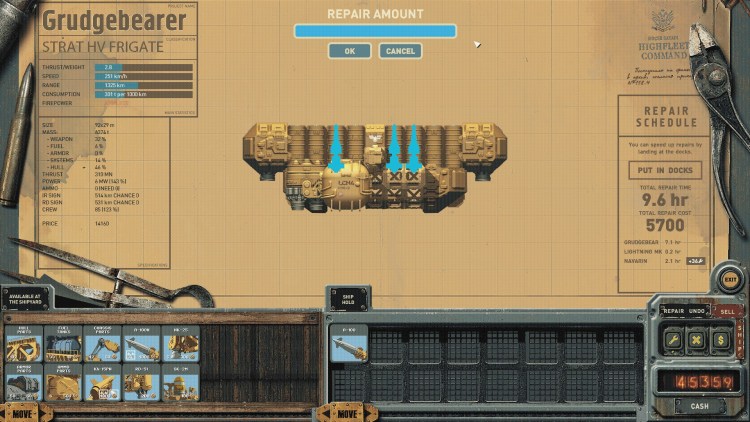
Not this guy, he’s only there to carry around huge missiles. Also, missiles, unlike guns, are rearmed in the same way destroyed components are repaired, which is… a little annoying at times.
Speaking of ships: the repair screen still bugs out on me. See, when you add or take away components from a ship, you change the blueprint, creating a new class. When you repair a ship, you get to choose which class blueprint to use, but you’re never told what parts will need to be replaced. And sometimes, the game refuses to give automatic repair settings, meaning that you need to click on every component yourself to see if they need some love.
This also ties into the bug where, sometimes, a ship that has nearly touched down will take controls away from you and plummet the last 100 meters. So your desire to get into that 76% repair speed increase shaft has just ended, causing you damage to the landing gear and possibly any engines on the underside of the ship. At least the developer recently released a patch that allows you to cancel the landing instead of endlessly retrying.
Saving grace
There are campaign map issues as well. However, they’re mostly limited to a tutorial NPC overlay getting stuck on top of everything, leading you with no option but to reload the save.
Speaking of saves, the game doesn’t allow you to do it manually. It saves when your flagship lands in a new city, and, if things go pear-shaped, you can reload from there. However, sometimes things get really hairy and you might want to reset your campaign. HighFleet understands — a lot more than other roguelikes — that making players grind out the first steps of the campaign isn’t good, so you can get meta save points by capturing fleet headquarters.
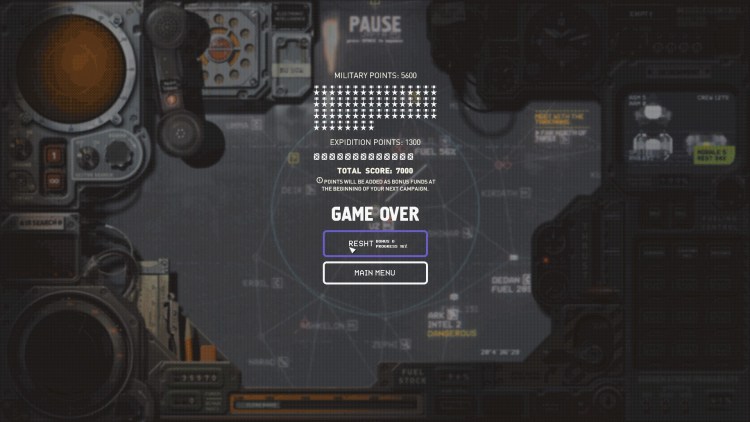
Progress seems to be tracked entirely by how far up the map you made it, so you can see I’ll be continuing my adventure being about 16% in.
But capturing HQs presents a couple of issues. You need to die to restart from that point (luckily, you get bonus funds depending on how well you did), but this isn’t mentioned in the game’s tutorial. It was one of the things that I had to learn by reading the manual. Sure, it’s a beautiful, well-written manual (though it does have its own issues), but it feels like it’s the kind of data that should have been explicitly introduced in the tutorial (the current mention is oblique at best).
On the subject of beauty, HighFleet is a gorgeous game. What else can be said there? The interface is tactile almost in the way that NautiCrawl was, and it looks amazing. Combat is rich with explosions and raindrops on your screen, and you can see ships get blasted apart piece by piece. I love it. The game’s characters are dieselpunk to the max, and you cannot not love it.
The audio is also fantastic. Voiced dialogue isn’t really a thing here, but the rest is ace. You’ll learn to judge weapons by the way they sound, and you won’t need to look at the screen to know what issues your ships are having — you can simply listen to suss out the situation.
It took me a whole lot of words, but I finally said it: HighFleet is a good game. It can be challenging, brutally so, and it has some issues with the way it handles things. But you can see the logic behind most of the concerns (that aren’t bugs), so it makes it easier to accept. Now if you’ll excuse me, I have to go back to dreaming of what an amazing thing this would be if the ship battles got the 3D treatment that Black Lab Games gave to Deadlock.

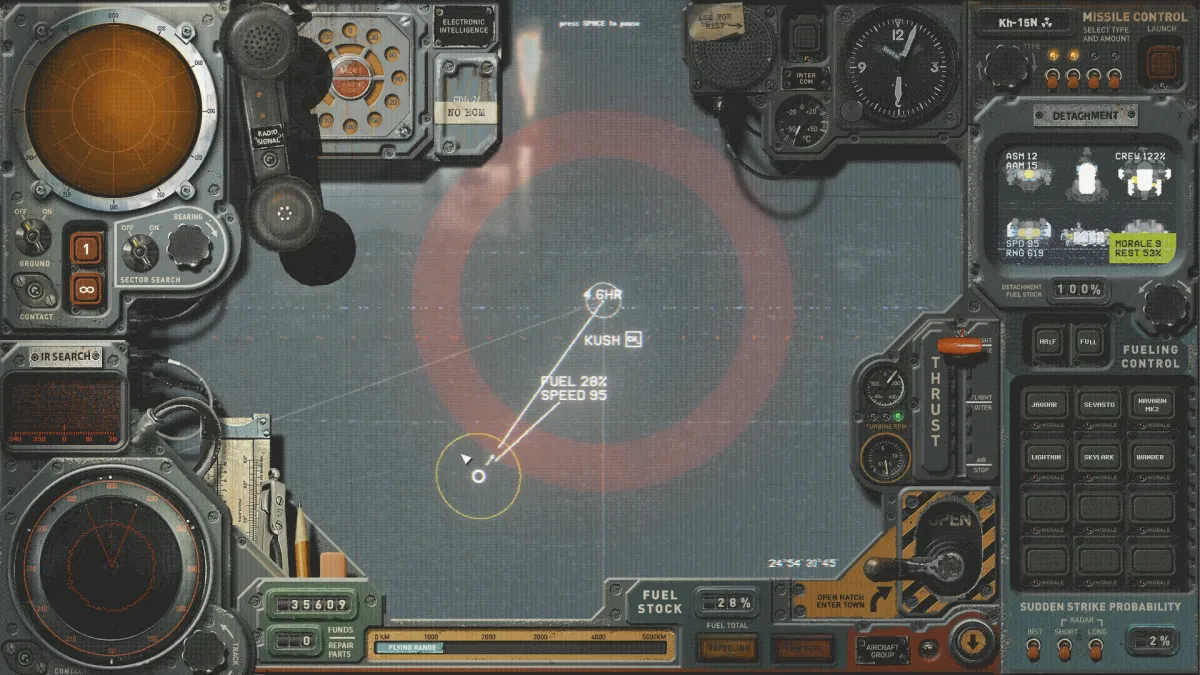

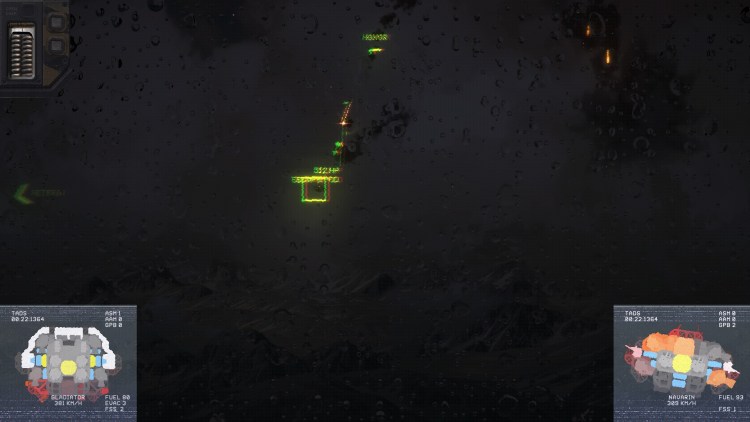
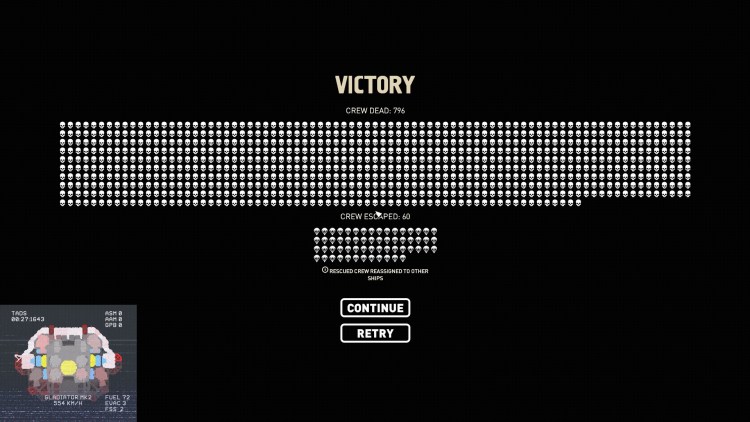


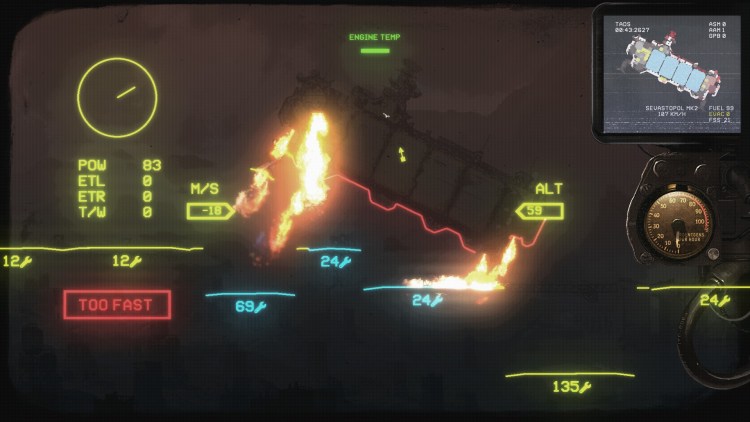
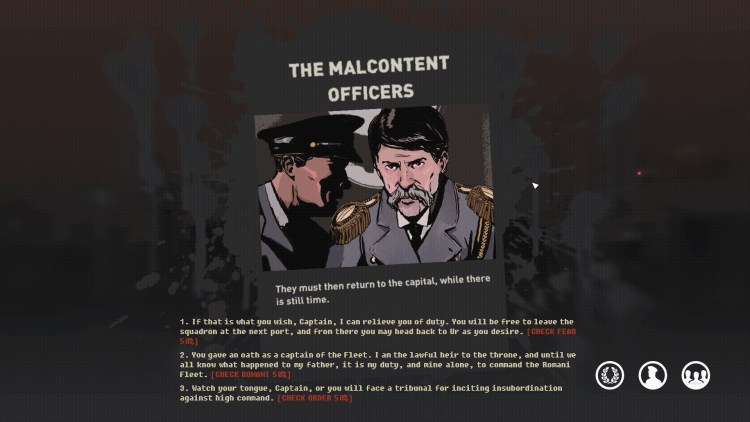





Published: Jul 26, 2021 01:01 pm